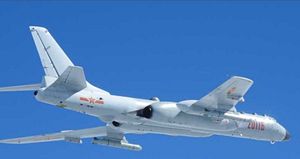The People’s Liberation Army Air Force (PLAAF) sent two Xian H-6K long-range bombers, two unidentified fighter jets, one Shaanxi Y-8 electronic countermeasures aircraft, and one Tupolev Tu-154MD electronic intelligence plane through international airspace between the Japanese islands of Okinawa and Miyako in the East China Sea on December 11, according to the Japanese Ministry of Defense (MoD).
The Japan Air Self-Defense Force (JASDF) scrambled Mitsubishi F-15J all-weather air superiority fighters in response. The Japanese MoD says that Japanese airspace was not violated.
While the two unidentified PLAAF fighter jets turned around after passing the strategically important Miyako Strait, located between the Japanese islands of Miyako and Okinawa, the remaining aircraft flew on through the Bashi Channel, a waterway between the Philippines and the Taiwanese island of Orchid, circling Taiwan.
The Republic of China Air Force (ROCAF) scrambled fighter jets in response. The Republic of China Navy (ROCN) also dispatched ships to monitor the PLAAF aircraft.
The PLAAF identified the two fighter jets as Su-30 (possibly MK2 variant) and Shenjang J-11 fighter aircraft. A PLAAF spokesperson called the operation a routine “patrol circling the island.”
“The jets flew over Bashi Channel and the Miyako Strait, and carried out trainings maneuvers, including circling the ‘island,’ which improves the force’s capability to safeguard China’s sovereignty and territorial integrity,” the Global Times quoted the PLAAF spokesperson as saying.
Long-range patrols are meant to “safeguard national sovereignty and territorial integrity,” the spokesperson added. “The [PLAAF] is progressing into a modern strategic armed force with the ability to fight in all domains.”
He also described the exercise as “legal and reasonable.”
While PLAAF aircraft regularly circle Taiwan, China has lately been also stepping up flight operations around the strategically important Miyako Strait — a principal entryway for the People’s Liberation Army Navy (PLAN) into the Pacific Ocean. Four H-6K bombers and one Shaanxi Y-8 electronic countermeasures aircraft flew through the waterway on December 9.
As I reported last month, on November 18 and 19 the PLAAF flew long-range bombers and support aircraft through the strait as part of what China has called “regular” drills.
“The [November 18-19 operation] was the first through the passageway since July when six H-6K bombers flew through the Miyako Strait and back,” I noted. “The PLAAF conducted similar exercises in the East China Sea, including flying through the Miyako Strait, in September, November, and December 2016.”
Japan had to scramble fighter jets in each instance. The JASDF stood up a new F-15J air wing on Okinawa in early 2016 to deal with increased PLAAF activity in the region.
Xian H-6K long-range bombers can be armed with up to seven YJ-12 supersonic anti-ship missiles — six on wing pylons plus one in the bomb bay — or nuclear/non-nuclear CJ-10A (KD-20) land-attack cruise missiles. Japan is in the process of procuring U.S. ground-based Aegis Ashore systems to defend against China’s and North Korea’s growing ballistic and cruise missile arsenals.

































